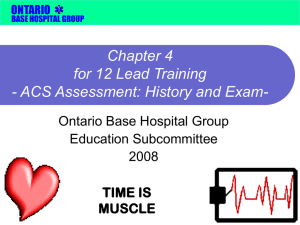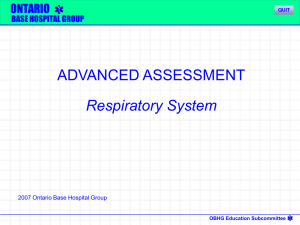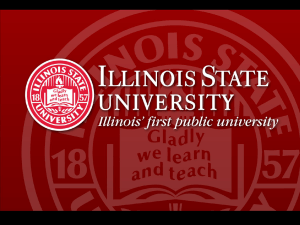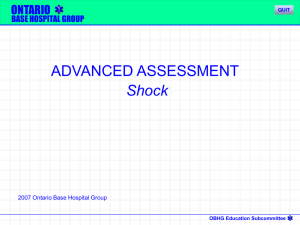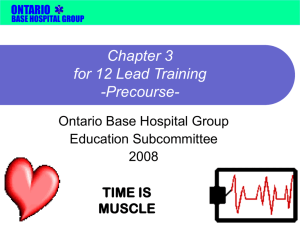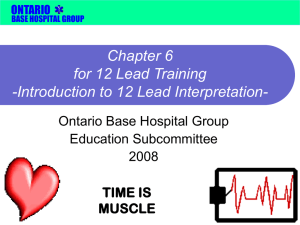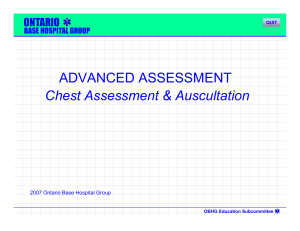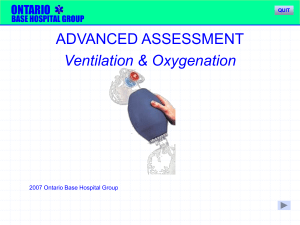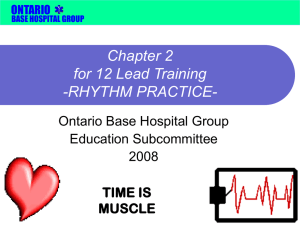Kevin McNab AEMCA, ACP
advertisement
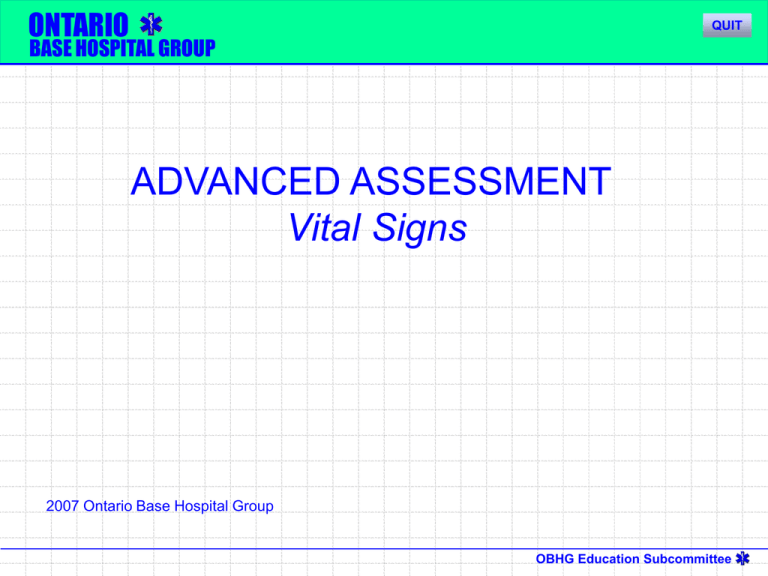
ONTARIO QUIT BASE HOSPITAL GROUP ADVANCED ASSESSMENT Vital Signs 2007 Ontario Base Hospital Group OBHG Education Subcommittee ADVANCED ASSESSMENT Vital Signs AUTHORS REVIEWERS/CONTRIBUTORS Mike Muir AEMCA, ACP, BHSc Lori Smith AEMCA, ACP Kitchener-Waterloo-Wellington Base Hospital Paramedic Program Manager Grey-Bruce-Huron Paramedic Base Hospital Grey Bruce Health Services, Owen Sound Kevin McNab AEMCA, ACP Quality Assurance Manager Huron County EMS Rob Theriault EMCA, RCT(Adv.), CCP(F) Peel Region Base Hospital Donna L. Smith AEMCA, ACP Hamilton Base Hospital Tim Dodd, AEMCA, ACP Hamilton Base Hospital References – Emergency Medicine 2007 Ontario Base Hospital Group OBHG Education Subcommittee VITAL SIGNS: PEARLS OBHG Education Subcommittee Pulse On patient arrival take a quick check of radial pulse. Present? Fast/Slow? Regular/Irregular Bilateral pulses? OBHG Education Subcommittee Pulse Helps to quickly identify the presence of underlying illness. Dysrhythmia? Hypovolemia? Etc. OBHG Education Subcommittee Cardiac Monitoring Lead II is commonly used for monitoring patients when a dysrhythmia exists that is difficult to interpret, look at other leads & adjust the ECG size as needed don’t rely on the monitor’s digital read-out for the heart rate – double check with a pulse assessment and by manually calculating the heart rate on the ECG graph paper. OBHG Education Subcommittee Blood Pressure Cuff size is important Too small = falsely high reading Too large = falsely low reading Loose cuff = falsely high reading Timing cuff deflation too slow = diastolic pressure falsely high cuff deflation too fast = systolic high & diastolic high OBHG Education Subcommittee Blood Pressure Hold the patient’s arm at about the level of the heart Avoid taking B/P over clothing! For B/P by palpation in a moving vehicle where it may be too noisy to auscultate and the pulses are weak, palpate the brachial artery OBHG Education Subcommittee Blood Pressure Bilateral blood pressures need to be taken and documented for chest pain – especially pain of a “tearing” quality that radiates to the back. Identify and attempt to rule out dissecting thoracic aortic aneurysm for thrombolytic therapy. In an acute thoracic aortic dissection, blood may dissect along one of the subclavian arteries resulting in a lower B/P in one arm compared with the other 15-20 mmHg difference in systolic pressure is considered pathological OBHG Education Subcommittee Blood Pressure Blood pressure measurement provides supportive evidence or good or poor perfusion – it’s not the definitive sign e.g. a systolic pressure of 100 mmHg may be normal for some people and it may be profoundly hypotensive for others Look for other signs of perfusion – e.g. mental status, skin colour, capillary refill, etc OBHG Education Subcommittee Mean Arterial Pressure (MAP) Average pressure reached inside the artery. Estimated by MAP=Pd+(Ps-Pd)/3 Normal values range between 77-97mmHg OBHG Education Subcommittee Respiration check rate, depth and rhythm, and also look for accessory muscle use, indrawing, symmetry, etc. estimate the patients level of respiratory distress based on the above, their ability to speak in full or broken sentences and their mental status. auscultate and interpret adventitious breath sounds – it is one of the cornerstones of Paramedic care If you feel your auscultatory skills need work, take advantage of senior partners, respiratory therapists, nurses and physicians to develop your skills OBHG Education Subcommittee Respiration - Paediatric crying will not prohibit you from doing a thorough chest auscultation – in fact, the baby tends to inhale deeply when crying, making it easier to auscultate look for chest wall and diaphragmatic movement to gauge the effectiveness of breathing speak with the parent(s). They will provide invaluable information about the patient’s level of distress compared to “normal” OBHG Education Subcommittee Respiration How would you define the term hyperventilation? A Respiratory rate greater than 20 bpm B Deep breathing C None of the above OBHG Education Subcommittee Respiration - misconception How would you define the term hyperventilation? A Respiratory rate greater than 20 bpm B Deep breathing C None of the above In fact, hyperventilation is defined as a “minute volume” (rate x volume) that exceeds the body’s metabolic demands • e.g. a patient may be breathing at a rate of 60 bpm and hypoventilating or breathing a 10 bpm and hyperventilating. • Rate or depth alone do not define “hyperventilation” • Hence it’s important to observe rate & depth closely OBHG Education Subcommittee Skin Not only assess skin colour, temperature and moisture, but also check skin turgor. Tent the skin on the back of the hand and see how fast it recoils (forehead may be more reliable location to assess turgor in the elderly). Indicates level of hydration, dependant on the age of the patient On infants, look for sunken eyes and fontanels for signs of dehydration OBHG Education Subcommittee Pupillary Response Assess the pupils response to light and that there is a consensual constriction of the opposite eye. Nystagmus? (involuntary eye movement) Deviation? Disconjugate gaze? OBHG Education Subcommittee Pupillary Response to Light Dilated and Unresponsive Cardiac Arrest CNS Injury Hypoxia/Anoxia Drug use/anticholinergic Unequal (one dilated and unresponsive) Stroke Head injury Direct trauma to the eye Eye med’s Constricted and Unresponsive CNS injury Narcotic OD/opiate use Eye med’s OBHG Education Subcommittee Level of Mentation Healthy patients: should be oriented to person, place and time. have organized thoughts and converse freely Use AVPU for primary survey, then the GCS OBHG Education Subcommittee Last Thought Remember to check postural vital signs (unless contraindicated) Change in pulse and blood pressure between sitting and supine OBHG Education Subcommittee ONTARIO START QUIT BASE HOSPITAL GROUP Well Done! Ontario Base Hospital Group Self-directed Education Program OBHG Education Subcommittee MENU SORRY, THAT’S NOT THE CORRECT ANSWER QUIT OBHG Education Subcommittee
